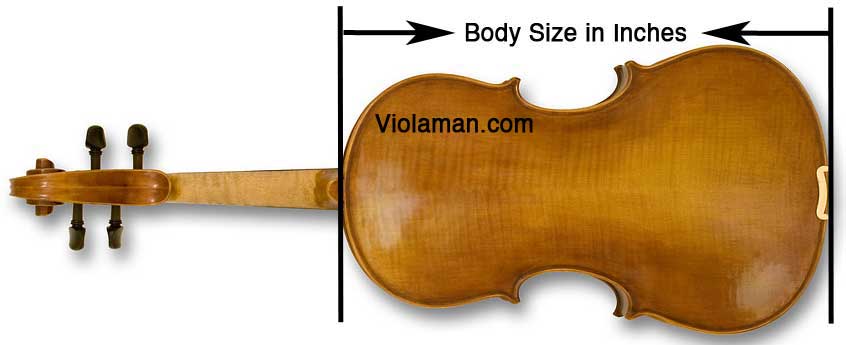What size viola do I need?
Most adults, regardless of their size use 16″ violas. Usually the bigger the instrument the better the sound. Therefor, if you are tall you may consider trying a 16 1/2″ size viola.
How to measure children or small adults for the correct viola size.
Extend your left arm fully outwards, pointed approximately at playing angle (somewhere between straight to the side and facing forward), and measure the distance from your neck to the middle of your palm. Use the chart below.
If the length is: Choose this size:
26″ or more 16″
24 1/2″ 15″
23″ 14″
21 1/2″ 13″
Sometimes the weight and, or size of a large viola can cause tensions and a small viola would be preferred for more comfort and ease of playing.
VIOLA TUNER – Tune your viola with this attractive, simple to use, viola tuner. See the string, peg and note that you want to tune.

These are the violas open strings in order. The first string is called A and is the highest open string on the viola and labeled with the roman numeral I. The next string is the D = II, then G = III with the lowest being the C = IV.
Download this VIOLA FINGERING CHART and put it in your practice room.
You can also put it by your bed to stare at before going to sleep or in the bathroom.

Hold the viola – Begin with your legs comfortably spread at about shoulder width apart. Start by placing the viola on your left shoulder/collar bone, lifting your chin slightly and placing the end pin of the viola towards the center of your neck. Lower your jaw/chin so that it rests comfortably on the chin-rest. Find a good comfort zone. If it is not comfortable you may eventually need to find a better chinrest. Do not over squeeze the viola to hold it, rather gently rest your head on the chinrest.
The viola should point slightly to the left. Not straight in front of you and not way off to the side. Keep the instrument high enough that you will be able to reach the tip of the bow and that it will remain balanced.

Hold the bow – Place your thumb in the C of the bow frog and place the other fingers on the other side of the stick with the pointer finger towards the tip of the bow. Keep the all the fingers comfortably together and relaxed. With the pinky curved and the tip on top of the stick, turn your hand counter-clockwise so that the fingers lay at an angle. The bow’s stick makes contact on the first fingers knuckle with each following fingers closer to their tips. Finally the pinky needs to learn to sit on top of the stick and stay there.
After learning to correctly hold the viola and bow begin by drawing the bow over the strings while concentrating on keeping a straight bow stroke at a selected contact point between the bridge and fingerboard. Draw long, slow, full bows and don’t be discouraged too soon about the sound. Use mostly elbow and very little shoulder movement. In the beginning use a mirror to learn the feeling of drawing straight bows. Don’t expect perfection right away. Even pros draw crooked bows. If the bow travels up and down the string towards and away from the fingerboard experiment with slight angles to find the right angle for drawing a straight bow.
Download and print fiddlermans RHYTHM CHART to learn how to count.
What size viola do you have?
Here is an illustration of how to measure a viola.


 Join the forum discussion on this post
Join the forum discussion on this post